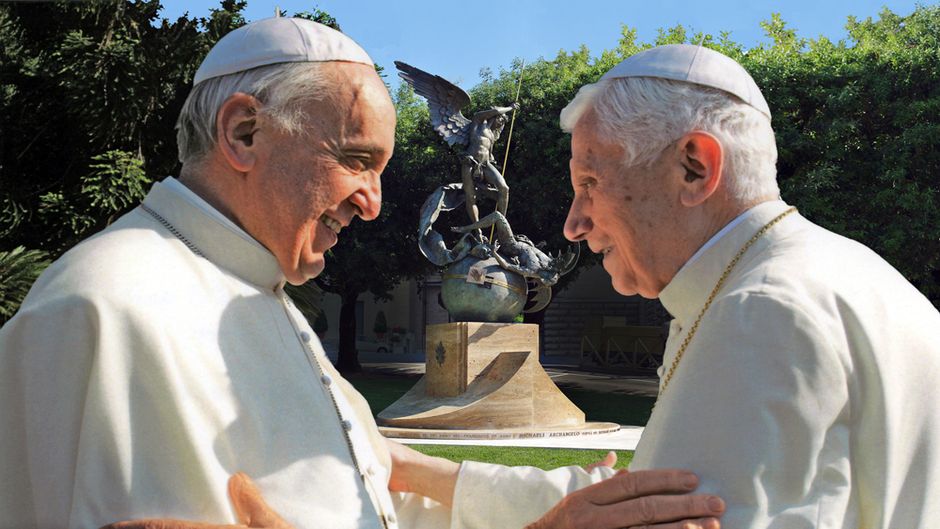In a double move, Francis closes the Ratzinger era. For now
Benedict XVI died at the end of 2022, but on July 1st, his shadow receded further from the Vatican.
02 AUGUST 2023 · 10:00 CET

Pope Ratzinger (1927-2022) died only seven months ago, but it is safe to say that on July 1st his era definitely ended, at least in the intentions of the reigning pope.
In a double move that would make a skilled checkers player envious, Pope Francis put an end to an unwieldy presence in his pontificate.
As a “pope emeritus” living in the Vatican (a situation that had never happened before in the millennial history of the Catholic Church), Ratzinger constituted a thorn in Francis’ side, albeit a silent one at least on the outside.
Light years removed in terms of theological training and ideas about the church, Francis had assigned him the “wise grandfather” role—a vexatious way of saying that he was an old man rich in memory but lacking in future prospects.
Benedict XVI died at the end of 2022, but on July 1st, his shadow receded further from the Vatican.
Francis’ first move was to dispatch Ratzinger’s secretary, Msgr. George Gänswein, to Freiburg, Germany, without assignments: away from Rome, deprived of ecclesiastical responsibilities.
The last rift between him and Francis had been the day after Ratzinger’s funeral with the publication of his book Nothing but the Truth. My Life at the Side of Benedict XVI , in which Gänswein had clearly spoken of the disagreements between the two popes.
Francis’ first move was to dispatch Ratzinger’s secretary, Msgr. George Gänswein, to Freiburg, Germany, without assignments
Francis had not liked either the timing or the content. Now Gänswein, who is only 66 years old (a “young” age for the church in Rome), has received the reciprocation that tastes like revenge served cold: a one-way ticket and a future without appointments.The message is clear: cohabitation with Ratzinger and his “inner circle” is over.
But there was another move in contrast to the Ratzingerian age. Before becoming pope, Ratzinger had been the powerful prefect of the Dicastery for the Doctrine of the Faith (formerly the Holy Office).
Upon becoming pope, in defense of Catholic doctrine, Cardinals Müller (German) and Ladaria (Spanish) had been appointed in his place. They are different in temperaments, but both “conservative” or “moderate” like Ratzinger.
The former had been his student, the latter had been secretary of the Dicastery in Ratzinger’s time. Two “loyalists.” There was no shortage of friction;
Müller had said that Pope Francis needed “theological framing” and, in the face of this “offense,” was promptly and abruptly dismissed by the pope.
Ladaria, a Jesuit like Bergoglio, has held a more defiladed and guarded position, but certainly not in line with the evolution of Francis’ papacy.
Now, coincidentally, on the very same day of Ratzinger’s former secretary’s departure, Ladaria, Ratzinger’s appointee to the Dicastery, was also dismissed on grounds of seniority.
In his place, Francis appointed Argentine Víctor Manuel Fernández. Not well known in international theological circles, Fernández is, however, a loyal follower of Pope Francis.
He is said to have been the ghostwriter of Evangelii Gaudium, the pontificate’s programmatic manifesto calling for a “missionary conversion” of his church; [1]
Amoris Laetitia, the exhortation that contains openings toward the Eucharistic inclusion of people in “irregular” states of life; and Laudato Sì’, the encyclical on environmental issues that is so popular in progressive circles.
Ladaria, Ratzinger’s appointee to the Dicastery, was dismissed on grounds of seniority. In his place, Francis appointed Argentine Víctor Manuel Fernández.
Virtually all the cornerstones of Francis’ magisterium were written in consultation with Fernández. In the aftermath of Evangelii Gaudium, he had written a book presenting the new papal course to the world: The Project of Francis. Where he wants to take the ChurchNow, this interpreter of Francis’ thinking, far removed from Ratzinger’s, became prefect of the Dicastery for the Doctrine of the Faith, the highest body for the promotion of Catholic doctrine.
Francis has a very faithful and “young” theologian (62 years old) in a position that can carry on his “project” even when he is gone. In Francis’ view, this really is a big deal.
The next two years will see two Synods of Bishops (gathering all Roman Catholic bishops from around the world) on the controversial topic of “synodality”, i.e., a new way of proceeding in the church, with Rome becoming more inclusive and absorbing (catholic) and less marked by its traditional identity (Roman). Francis has now a trusted supporter and enthusiastic promoter of his view of “synodality.”
In two moves, Francis has shrewdly weakened the “Roman-ness” of the church as interpreted by Pope Benedict XVI and scored a point in favor of the “catholicity” of the current fluid church, the one where we are “all brothers.” While physically frail, Francis has never been stronger than he is now.
Leonardo De Chirico, theologian, author and evangelical pastor in Rome.
1 Here is a recent summary of Evangelii Gaudium from the Pope himself: “Here we find the ‘heart’ of the evangelical mission of the Church: to reach all through the gift of God’s infinite love, to seek all, to welcome all, excluding no one, to offer our lives for all. All! That is the key word.” Audience to the General Assembly of the Pontifical Mission Societies (June 3rd, 2023).
Published in: Evangelical Focus - Vatican Files - In a double move, Francis closes the Ratzinger era. For now
